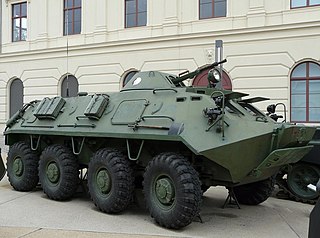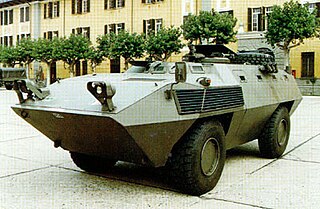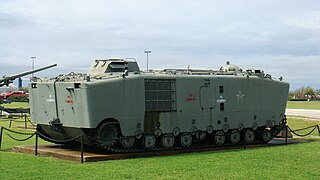 W
WThe ABC-79M (4x4) armoured personnel carrier has been developed in Romania and uses some automotive components of the TAB-77 armoured personnel carrier. Although previously known as TABC-79, it is now known as the ABC-79M.
 W
WThe Assault Amphibious Vehicle (AAV)—official designation AAVP-7A1 —is a fully tracked amphibious landing vehicle manufactured by U.S. Combat Systems.
 W
WThe Bobcat was an armored personnel carrier (APC) designed and built in Canada in the 1950s and early 1960s. A lengthy development period and changing requirements drove the price up while not improving the basic design, and the project was eventually cancelled in late 1963 in favor of purchasing the ubiquitous M113.
 W
WThe BTR-3 is an Eight-wheel drive armored personnel carrier developed in 2000-2001 by an international consortium. The companies involved in the project include the Kharkiv Morozov Machine Building Design Bureau of Ukraine, the ADCOM MANUFACTURING Company of Abu-Dhabi, UAE, and the State Scientific Technical Centre of Artillery & Rifle Arms of Ukraine. Although somewhat similar in appearance to the Russian BTR-80, the BTR-3U is an all-new production vehicle rather than an update of the existing in-service vehicle.
 W
WThe BTR-4 "Bucephalus" is an amphibious 8x8 wheeled armoured personnel carrier (APC) designed in Ukraine by the Kharkiv Morozov Machine Building Design Bureau.
 W
WThe BTR-70DI is a Ukrainian upgrade of the Soviet BTR-70 with BTR-80 hatch and new diesel engines.
 W
WThe BTR-50 is a Soviet amphibious armored personnel carrier (APC) based on the PT-76 light tank. The BTR-50 is tracked, unlike most in the BTR series, which are wheeled. The BTR-50 shares many similarities with two other APCs, the OT-62 TOPAS and the Type 77. While the OT-62 is an improved copy of the BTR-50 developed jointly by Czechoslovakia and Poland, the Type 77, based on the Type 63 amphibious light tank developed by the People's Republic of China (PRC), is not a copy of the BTR-50.
 W
WThe BTR-60 is the first vehicle in a series of Soviet eight-wheeled armoured personnel carriers (APCs). It was developed in the late 1950s as a replacement for the BTR-152 and was seen in public for the first time in 1961. BTR stands for Bronetransporter.
 W
WThe BTR-70 is an eight-wheeled armored personnel carrier originally developed by the Soviet Union during the late 1960s under the manufacturing code GAZ-4905. On August 21, 1972, it was accepted into Soviet service and would later be widely exported. Large quantities were also produced under license in Romania as the TAB-77.
 W
WThe BTR-80 is an 8×8 wheeled amphibious armoured personnel carrier (APC) designed in the USSR. It was adopted in 1985 and replaced the previous vehicles, the BTR-60 and BTR-70, in the Soviet Army. It was first deployed during the Soviet–Afghan War.
 W
WBTR-90 (GAZ-5923) is an 8×8 wheeled armored personnel carrier developed in Russia, designed in 1993 and first shown publicly in 1994. It is a larger version of the BTR-80 vehicle, fitted with a BMP-2 turret. Armour protection is improved compared with the BTR-80, giving protection from 14.5 mm projectiles over the frontal arc.
 W
WThe BTR-94 is a Ukrainian amphibious armoured personnel carrier (Bronetransporter), a modification of the Soviet eight-wheeled BTR-80. The BTR-94's turret BAU-23x2 is larger than the BTR-80's BPU-1 and is fitted with a twin 23x152mm gun 2A7M with 200 rounds, a coaxial KT-7.62 machine gun with 2,000 rounds, six 81 mm smoke grenade launchers and a combined optical sight 1PZ-7-23. Each 2A7M gun has a max. rate of fire of 850 rds/min. The same gun is mounted on the ZSU-23-4. The BAU-23x2 module can also be mounted on other armoured vehicles like the BTR-70 or Ratel IFV.
 W
WThe DefTech AV8 Gempita (Thunder) is an amphibious multirole armoured vehicle developed by Malaysian defence company DefTech with the assistance of Turkey defence company FNSS. The Gempita resembles some of the Turkey FNSS Pars design and technology. The vehicle has a modular design which allows the fitting of different turrets, weapons, sensors, and communications systems on the same vehicle.
 W
WThe EE-11 Urutu is a Brazilian amphibious armored personnel carrier. It was based on the drive train and chassis components of the EE-9 Cascavel armored car and initially emerged as part of a project to develop an amphibious troop-carrying counterpart to that vehicle for the Brazilian Army and Marine Corps (CFN). The first pre-production models entered service with the CFN in 1973 and serial production commenced the following year. While the CFN declined to adopt the EE-11 Urutu in large numbers, the Brazilian Army was more forthcoming and purchased 223; these entered service in 1975.
 W
WThe Enigma is an 8×8 wheeled amphibious armored personnel carrier developed by Emirates Defense Technology in UAE. It was introduced at IDEX 2015.
 W
WThe Fiat Type 6614 is a 4x4 wheeled armoured personnel carrier developed as a joint venture between Fiat and Oto Melara of Italy. The hull is welded steel, and the vehicle is amphibious. The first prototype was built in 1972.
 W
WThe Pars is an amphibious Armoured combat vehicle family with 4x4, 6×6 and 8×8 versions, produced by FNSS Defence Systems of Turkey.
 W
WThe FV432 is the armoured personnel carrier variant in the British Army's FV430 series of armoured fighting vehicles. Since its introduction in the 1960s, it has been the most common variant, being used for transporting infantry on the battlefield. At its peak in the 1980s, almost 2,500 vehicles were in use.
 W
WThe Kurganets-25 is a tracked, 25-ton modular infantry fighting vehicle and armored personnel carrier being developed for the Russian Army. The Kurganets-25 will evolve into various models, gradually replacing BMP, BMD, MT-LB and other types of tracked Soviet armored platforms. The Kurganets-25 will have modular armor that can be upgraded for specific threats.
 W
WThe LVTP-5 is a family of amphibious armored fighting vehicles used by the Philippine Marine Corps and formerly, the United States Marine Corps. It was designed by the BorgWarner company and built by FMC along with a few other companies. It was first accepted into service in 1956. Some 1,124 basic units were produced, plus the specialist variants, and many saw action in the Vietnam War.
 W
WThe M76 Otter was an amphibious cargo carrier used by the United States Marine Corps (USMC).
 W
WThe M113 is a fully tracked armored personnel carrier (APC) that was developed and produced by the Food Machinery and Chemical Corporation (FMC). The M113 was sent to United States Army Europe to replace the mechanized infantry's M59 APCs from 1961. The M113 was first used in combat in April 1962 after the United States provided the South Vietnamese Army (ARVN) with heavy weaponry such as the M113, under the Military Assistance Command, Vietnam (MACV) program. Eventually, the M113 was the most widely used armored vehicle of the U.S. Army in the Vietnam War and was used to break through heavy thickets in the midst of the jungle to attack and overrun enemy positions. It was largely known as an "APC" or an "ACAV" by the allied forces.
 W
WThe M116 Husky was a tracked amphibious cargo carrier/marginal terrain vehicle that served with the United States Marine Corps.
 W
WThe MT-LB is a Soviet multi-purpose fully amphibious auxiliary armored tracked vehicle, which was introduced in the 1950s. It is also produced in Poland, where its YaMZ engine was replaced by a Polish version.
 W
WThe MT-LBu is a Soviet multi-purpose fully amphibious armoured carrier which was developed under the factory index Ob'yekt 10 in the late 1960s, based on the MT-LB. It has a more powerful engine, a 40 cm higher hull and a longer chassis with 7 road wheels on each side.
 W
WEjder (Turkish:"Dragon") is a family of armoured vehicles produced by Turkish company Nurol Makina. It consist of two version which is 4x4 and 6x6.
 W
WThe Opal-I is a multi-purpose fully amphibious armoured personnel carrier developed and produced by HSW S.A. in Poland. APC is a development of MT-LB that was produced in HSW under licence. Major changes are reworked nose section and fitted propellers for better floating speed and manoeuvrability, new turret with 12.7 mm NSVT machine-gun instead of old one with 7.62 PKT and powered-up engine. Opal-II is a stretched variant with longer chassis with 7 road wheels on each side, like the 2S1 and MT-LBu and 300 hp (220 kW) SW680T engine.
 W
WThe OT-62 TOPAS is a series of amphibious tracked armoured personnel carriers developed jointly by Polish People's Republic and Czechoslovakia (ČSSR). OT-62 stands for Obrněný Transportér vzor 62 – "armoured personnel carrier model 62". TOPAS stands for Transportér Obrněný Pásový – "tracked armoured personnel carrier".
 W
WThe Saur 1 is an armoured personnel carrier developed by the Romanian company ROMARM in 2006.
 W
WThe TPz (Transportpanzer) Fuchs ("fox") is a German armoured personnel carrier originally developed by Daimler-Benz but manufactured and further developed by the now Rheinmetall MAN Military Vehicles (RMMV). Fuchs was the second wheeled armoured vehicle to enter service with the Bundeswehr and it can be used for tasks including troop transport, engineer transport, bomb disposal, Nuclear, Biological and Chemical reconnaissance and electronic warfare. RMMV and its predecessors manufactured 1,236 Fuchs 1, mostly for the German Army.
 W
WThe Norinco Type 77 is a Chinese amphibious armoured personnel carrier. First fielded in 1978, it is in many ways similar to the earlier Soviet BTR-50. However the two vehicles share little in their designs, as the Type 77 is based on the Type 63 light tank.
 W
WThe VBTP-MR Guarani is a 6×6 armoured personnel carrier developed by Iveco and the Brazilian Army as part of its "URUTU-III" modernization program aimed to replace all EE-11 Urutu by 2015. The 8x8 version of the VBTP-MR is the base of Iveco's Superav armoured personnel carrier. In the program other Brazilian Companies also participated, such as IMBEL (Communications), ELBIT (Armaments), Usiminas and Villares.
 W
WThe VPK-7829 Bumerang is a modular amphibious wheeled infantry fighting vehicle and armored personnel carrier being developed by Russian Military Industrial Company (MIC) for the Russian Army.
 W
WThe WZ-523 is a six-wheeled Chinese armored personnel carrier designed to be amphibious. Built on the chassis of the Hanyang HY472 truck, it can carry a crew of three and seat up to eight additional passengers. Two primary models were produced—one with a roof-mounted 12.7mm heavy machine gun, and the other with a small turret armed with a 35mm grenade launcher and a 7.62mm co-axial general purpose machine gun. An export model that entered service in 2008 as a fire support vehicle was also marketed successfully to the Namibian Army; this is armed with a 73mm 2A28 Grom smoothbore cannon in exactly the same turret as used on the Soviet BMP-1 infantry fighting vehicle.
 W
WThe WZ-551 is a Chinese wheeled armored personnel carrier. The name WZ-551 actually covers two families of vehicles with the official designations in the People's Liberation Army of Type 90 and Type 92. Roughly 900 WZ-551s are in service with the PLA, where they are used by light mechanized infantry units. WZ-551s have been exported to Algeria, Bosnia, Sri Lanka, Nepal, Pakistan and Senegal.